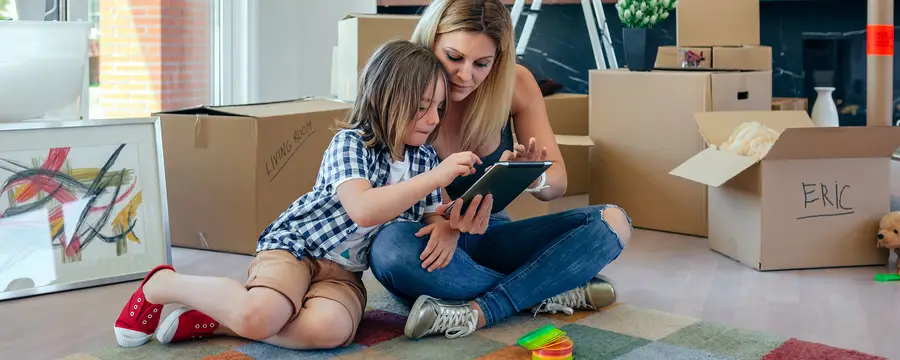Combining housing and services to help families live more stable lives
Objective:
Conduct a longitudinal survey of families who were provided with housing and other supports after involvement in the child welfare system.
Approach:
We created and administered computer-based interviews of families at five sites across the United States.
Impact:
We achieved an 80 percent response rate and contributed results to the Urban Institute's complete evaluation of the supportive housing demonstration. We are continuing our partnership for a study of the demonstration's long-term outcomes.
For families facing multiple crises, a stable home can set the stage for a better life.
That was the case with Sabrina, a young mother whose experience contributed to a recent study led by the Urban Institute. A former foster kid herself, Sabrina became a parent at the age when many young adults go to college. She struggled to get her life on track, and eventually her children went into foster care.
During the 18 months Sabrina worked on getting her kids back, her child welfare case manager referred her to Partners United for Supportive Housing, a program that placed her in a home. She no longer had to move from place to place or pay unsustainably high rent each month. The level of stress in her life dropped dramatically.
After moving into her new home, attending parenting classes, and working with her case manager, Sabrina felt positive and hopeful. She started working in construction, and her children returned to her. It was still hard sometimes to develop a routine and find the energy to play with the kids after a long day at work, but her life was not falling apart.
Sabrina’s family was one of more than 800 who took part in a federally sponsored demonstration of how supportive housing can help families involved in the child welfare system. This intervention combines affordable housing with intensive wraparound services. Her story is part of a report that the Urban Institute compiled to assess the demonstration’s effects.

Testing Supportive Housing in Five Communities Across the United States
The demonstration began in 2012, when the U.S. Department of Health and Human Services, in partnership with four private foundations, organized “Partnerships to Demonstrate the Effectiveness of Supportive Housing for Families in the Child Welfare System.”
The demonstration provided five-year, $5 million grants to five sites across the nation: Broward County, Florida; Cedar Rapids, Iowa; Memphis, Tennessee; San Francisco, California; and the state of Connecticut. The sites each provided supportive housing to homeless and unstably housed families involved in the child welfare system.
The demonstration provided resources for technical assistance, a local evaluation, and a national evaluation to assess outcomes across the five selected sites. The national and local evaluations of this demonstration test the supportive housing model on a larger scale than what has been done previously, with over 800 families involved in the child welfare system.
The Urban Institute led the national evaluation, coordinating with local evaluators, providing technical assistance to the sites on data collection and analysis, and determining the overall impact of the initiative and its cost effectiveness. RTI got involved in 2014, carrying out a longitudinal survey of families in each of the five sites to support Urban’s impact analysis.
Participating families were assigned to two groups—one that received supportive housing as part of the study and one that received “usual care” services. RTI administered in-person surveys to parents and caregivers at baseline and 12 months after they were randomized into the study. The survey was identical in each site and collected data on housing stability, family stability, and parent and child well-being. RTI was responsible for programming the family survey into a computer-based interview, conducting outreach to families, administering the baseline and 12-month follow-up surveys, and obtaining permission from participants to link their administrative data (e.g., records from the local child welfare agencies) with their survey responses. RTI achieved an 80% response rate for both the baseline and 12-month follow-up with families who agreed to be contacted for the research. RTI tracked families between waves by blending various locating strategies, including panel maintenance mailings and the use of interactive tracing databases. RTI also worked closely with service providers and child welfare agencies to locate families.
To better understand family experiences with supportive housing and usual care services, RTI also scheduled a subset of families to participate in a qualitative interview with an Urban Institute researcher. These in-depth interviews allowed the Urban Institute to collect firsthand reports from sample members to gain a better picture of families’ circumstances and how supportive housing influences family outcomes.
Following Families to Learn about Long-Term Effects
The Urban Institute found that supportive housing can improve families’ lives by increasing stability. Through the demonstration program, some sites were able to keep children with their parents and reduce families’ involvement in the child welfare system. Not every site showed the same results, but this research shows that parents’ relationships with their children often improved after moving into supportive housing. Paying rent and utilities was less of a burden for parents in supportive housing. These are important components of a less-stressful life for the parents and children in our study.
Still, the research team recognizes that the 24-month period of our study is not long enough to fully measure the paths these families’ lives will take. In 2017, the Urban Institute received funding from the Robert Wood Johnson Foundation to conduct an additional round of interviews with families roughly 5 years after enrollment (initial randomization) into the study. RTI is following up with participating families that will provide additional information on their long-term outcomes, and on the promising possibilities of supportive housing.
- Urban Institute


